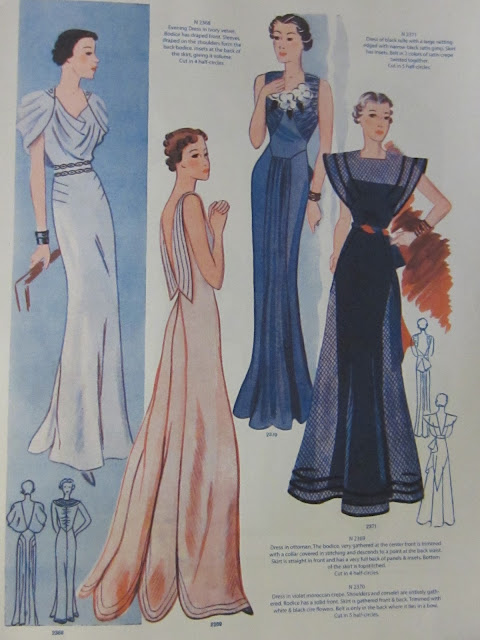It is not hidden object here that I have a soft spot for German patterns, to be most specific, those found in Der Goldene Schnitt. But, that is only half the story because I have an interest for pattern as a whole. How they come together, how they made fashion more obtainable, and how each country had their own unique pattern development system for the average woman. In France that pattern system was called the Éclair Coupe Paris. Like in the German version, the Éclair Coupe Paris has patterns for any kind of garment you could imagine from day dresses to town dresses and from evening wear to sports wear. There was even men's wear and children's wear.
This system was developed in the very early 30s and even the late 20s so I believe that it does predate the German system but only by a couple of years. How this system works is incredible similar to the one used in Der Goldene Schnitt in that it allows you to scale out a pattern to fit your size using your bust measurement. With is measurement, you cut out a specially developed tape (not exactly a ruler) with numbers on it. Using that special tape, you scale out the pattern you want. Sounds quite familiar yes? Yes, it is. Once you have your special tape cut out, you place that on the edge of the pattern. Following the numbers, you scale out the pattern. Once the pattern has been scaled out, you must cut it out and separate the pattern pieces. The pattern pieces are clustered together and once separated, add your seam allowance.
The differences? One major difference between the French and German system is that I think the French system does a much better job of saving paper than the German one. In the French one, you place the pattern on the edge of the paper and not in the middle. These patterns are also set in a half circle (the half circle edge goes on the edge of the pattern), are more clustered together, and are incredible basic and simple in shape. The skirts also do not scale out to the complete length, you must add in the rest and also add in seam allowances. One flaw that I have noticed with this system is that the patterns do not fit well off the bat.
In my early attempts with this pattern system, I tried a simple dress and the bodice fit very uncomfortably even with many adjustments. Same to the sleeves. The shape of the sleeve head was very underdeveloped and poorly fitting. In scaling out the patterns, the numbers were difficult to decode at times and to determine which number went to what point. . . . What do the patterns look like: Take a look below:
To fully elaborate on how to use this system, lets take an example. This lovely blue dress here looks like a really nice one to play with . . So, we study this dress and do you see that number there at he bottom between her feet? That is the pattern number. Remember that number.
With the number in mind, go to the back of the book where all the patterns are kept and find that number on the pattern pieces we need. Found them? The number 1530 is in three half circles so we need to have all three of the half circles to scale out this pattern. As you can see, it is in French. 'Devant' is the front, 'dos' the back, and 'manche' the sleeve. Do you see the little dots and the little 'x''s? THe dots on the lines are for cures, the 'x''s are indicators of points or corners.
Captivated by this pattern system and want to try it for yourself? You can find reprinted copies of the book on ebay. Remember to but the tapes to actually use the systems because you cannot use the Lutterloh ruler (I know because I tried). You will also want to have the master book to access many of the patterns. One interesting thing I noticed about his system that also sets it apart form the German one is that the Éclair Coupe Paris released many books throughout the fashion season to keep their readers fashionable current. In these seasonal books, sometimes only half a pattern is given while the rest of the pattern must be retrieved from the master book. Interesting sales gimmick too, yes? I thought so. So, if you choose to try these patterns, but the master book before you try the other ones.
 |
| The Master Book |




















